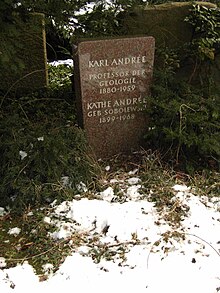Karl Erich Andrée
Karl Erich Andrée (born March 10, 1880 in Münder am Deister , † August 18, 1959 in Göttingen ) was a German geologist and paleontologist .
Life
Andrée was the youngest son of the pharmacist Adolf Andrée (1841–1917) and his wife Anna Henriette geb. Duntze, adopt. Bömers. In 1887 the family moved to Hanover, where the father became director of the city's botanical garden. Karl attended the humanistic high school Lyceum I there until Easter 1898 . After two semesters of chemistry at the Technical University of Hanover , he switched to the Philosophical Faculty of the Georg-August University of Göttingen on April 27, 1899 , where he mainly studied mineralogy, later more geology, paleontology and zoology. In Göttingen he became a member of the Cheruscia gymnastics club.
At the suggestion of Adolf von Koenen , he wrote his dissertation on the geology of Bad Iburg and in September 1904 he received his doctorate in Göttingen. In 1905 he served as a one-year volunteer in the 1st Battalion of the 2nd Kurhessian Infantry Regiment No. 82 in Göttingen. From 1906 to 1908 he was an assistant at the Geological Institute of the Clausthal Mining Academy . On May 26, 1906, he married Helene Rathkamp, with whom he had four children. From 1908 to 1910 he was an assistant at the Technical University of Karlsruhe . Habilitated in geology and palaeontology since 1910 , he was a private lecturer at the Philipps University of Marburg until 1915 .
The Albertus University of Königsberg appointed him in 1915 as associate professor of geology and paleontology. In 1922 he received the full professorship . Andrée became director of the Geological-Paleontological Institute and the amber collection of the Albertina. In addition, Andrée, along with Gustav Angenheister , Immanuel Friedländer , Beno Gutenberg , Franz Kossmat , Gerhard Krumbach , Karl Mack , Ludger Mintrop , Peter Polis , August Heinrich Sieberg and Emil Wiechert, was one of the founding members of the German Seismological Society founded on September 19, 1922 in Leipzig , today's German Geophysical Society. For the academic year 1930/31 he was elected rector of the University of Königsberg. He contributed significantly to the establishment of the sponsorship between the Königsberg and Göttingen universities.
Politically, Andrée was close to the DNVP during the Weimar Republic .
After his wife died in 1929, Andrée married Käthe Sobolewski in 1931 , with whom he had a daughter.
He went on scientific excursions in the Teutoburg Forest and Munster Basin. After fleeing from East Prussia in January 1945, he was taken over the following year by the University of Göttingen, where many university professors from the eastern regions of the German Reich had come. Andrée held lectures there until 1951 .
Memberships
- 1902 German Geological Society
- 1910 Geological Association
- 1912 Paleontological Society
- 1922 German Seismological Society
Honors
- Honorary member of the Prussia ancient society
- Hans Stille Medal (1948)
Fonts
- The Teutoburg Forest near Iburg. Inaugural dissertation to obtain the doctorate of the high philosophical faculty of the Georg-August-Universität zu Göttingen, printed by Louis Hofer, Göttingen 1904. Archive
- Seabed geology. Volume II. Soil Quality, Usable Materials on the Sea Floor. Published by the Borntraeger brothers, Leipzig 1920.
- The Curonian Spit. Gräfe and Unzer, Königsberg, 1932, reprint 1989.
- Amber and its importance in the natural sciences and humanities, arts and crafts, technology, industry and trade. Gräfe and Unzer, Koenigsberg, 1937
- The amber. Franckh, 1951.
literature
- Reichs Handbuch der Deutschen Gesellschaft - The handbook of personalities in words and pictures , first volume. Deutscher Wirtschaftsverlag, Berlin 1930, pp. 26/27, ISBN 3-598-30664-4 .
- Who is it . 1935, p. 24.
Web links
- Literature by and about Karl Erich Andrée in the catalog of the German National Library
- Geoscientist from Iburg - Karl Andrée
Individual evidence
- ↑ Otto von Schott: The Königsberg corporation students from 1918 to 1933 . The Ostpreußenblatt, January 4, 1997.
- ↑ Rector's speeches (HKM)
- ^ A b Robert Albinus: Königsberg Lexicon . Wurzburg 2002
- ^ Christian Tilitzki : The Albertus University in Königsberg in transition from 1932 to 1934 , in: Christian Pletzing (ed.): Outposts of the Reich? East Prussia 1933-1945 . Munich 2006, p. 62.
- ^ Palaeontological Journal 1, Issue 1, March 1914
| personal data | |
|---|---|
| SURNAME | Andrée, Karl Erich |
| BRIEF DESCRIPTION | German geologist and paleontologist |
| DATE OF BIRTH | March 10, 1880 |
| PLACE OF BIRTH | Mouths on the Deister |
| DATE OF DEATH | August 18, 1959 |
| Place of death | Goettingen |
